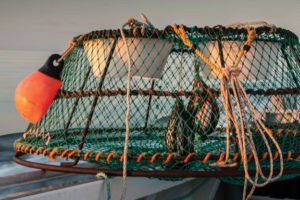 Recreational fishing is at its peak off the West Coast at the moment, with salmon, rockfish, halibut, tuna, and of course Dungeness crab for the taking. For those not familiar with recreational crabbing and may want to give it a go, looking at a crab pot may feel akin to opening Pandora’s box. Here’s a couple of aspects about crab pots to help you get started.
Recreational fishing is at its peak off the West Coast at the moment, with salmon, rockfish, halibut, tuna, and of course Dungeness crab for the taking. For those not familiar with recreational crabbing and may want to give it a go, looking at a crab pot may feel akin to opening Pandora’s box. Here’s a couple of aspects about crab pots to help you get started.
Crab pots are constructed using an iron frame and wrapping netting or wire mesh around it, with two funnel shaped openings where the crab enter. To prevent the crab from doing a rapid exit, there are trigger devices in the tunnel. If the pot has the trigger device, it is required to have a 4 ¼ inch inside diameter escape ring. This allows for smaller crab (particularly undersized crab) to escape.
A significant issue for any fishery is the risk of “ghostfishing.” Ghostfishing is when fishing gear is left in the water because it was lost, forgotten about, or some other unforeseen reason, and continues to catch crab. Crab pots left behind may have animals die inside them, which may attract more animals that in turn die, which may attract more. This is the reason it is required to have a biodegradable (typically cotton line) escapement device (usually a part of the pot that will biodegrade and eventually allow animals to escape).
Depending on where you plan to go fishing, lightweight pots might be suitable. If there are strong currents in your area, however (such as in parts of the Puget Sound) then you may lose your pot if it gets carried away. I have weighed down pots with rocks before, however the rocks can then potentially take up space from crab that would otherwise find their way in to your pot.
You may hear crabbers mention the scope of the line, which is how much line you have attached to your pot. Make sure to allow for enough line – you want your pot to sit on the bottom (that’s where the crab are!) but you need to take in to account currents. If currents are strong enough, they can potentially drag your buoys underwater, and you won’t find them until currents lessen or change. You also need to account for tidal changes as well. If the tide comes in and you didn’t give enough line, your buoy may be submerged. The other risk of this is that if you used a lightweight pot, or you overcompensated on the number of floats, your pot could float or bounce on the bottom, and be carried away with current. However, you also don’t want to give out so much line that you are putting other recreational boaters at risk of getting a line tangled in their prop! To prevent this, you need to weigh down the lines with a small weight, just enough to keep the line submerged. The advice I have gotten from fisherman is to look at the depth marked on your hart, or the area that you are fishing, and double that for the length of line.
Pots keep the crab in great condition, and so if you do find crab that cannot be kept (are either females or are too small), then they have a better chance of surviving when they are returned to the water. Take crab expert Dr. Noelle Yochum’s advice when returning crab to the water, and drop them as gently as possible to prevent their shells from cracking (and definitely don’t do the “Frisbee toss” I have seen many fishermen do!). Stay safe out on the water, definitely double check your local regulations, and have fun crabbing!